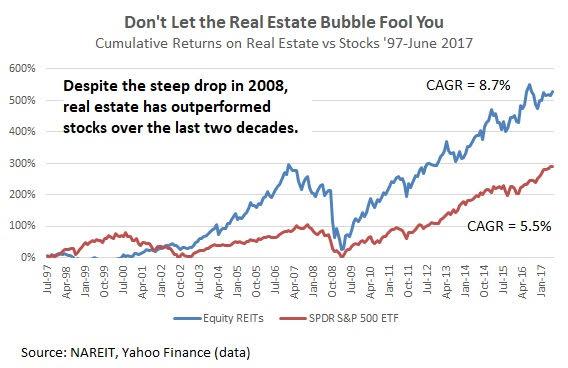In an ever-evolving economic landscape, the real estate sector consistently demonstrates a remarkable capacity for resilience and adaptation. This article delves into the performance of property stocks in response to shifting market dynamics, regulatory changes, and technological advancements. By examining key indicators and strategies employed by leading real estate companies, we aim to uncover how these entities have navigated challenges and seized opportunities within their markets. Our analysis will provide a comprehensive overview of the current state of property stocks, shedding light on their potential for future growth and stability in a changing world.
Table of Contents
- Real Estate Market Trends and Implications for Property Stocks
- Adaptation Strategies for Real Estate Stocks in Volatile Markets
- Investment Opportunities in Resilient Real Estate Sectors
- Portfolio Recommendations for Maximizing Returns in Property Stocks
- Introduction

Real Estate Market Trends and Implications for Property Stocks
The current landscape of the real estate market reveals a nuanced picture of adaptation and resilience among property stocks. With shifts in both consumer preferences and economic conditions catalyzed by ongoing global events, real estate investments are navigating through challenges while uncovering potential opportunities for growth.
Key Trends:
- Shift towards suburban and rural properties as remote work becomes more normalized, reducing the demand for urban office spaces.
- Growing interest in residential properties with adaptable spaces, indicating a demand for homes that can double as workspaces.
- Increased investment in industrial real estate driven by the surge in e-commerce and need for more warehousing and distribution centers.
The implications of these trends on property stocks are multifaceted. For instance, companies focused on commercial real estate are experiencing variable impacts based on their portfolio composition. Those with significant holdings in office spaces might face challenges, whereas companies investing in industrial properties are seeing growth. To illustrate, the following table provides an overview of recent performance metrics for selected property stocks, highlighting differing impacts based on sector exposure:
| Company | Sector | Q1 Performance | Year-over-Year Change |
|---|---|---|---|
| Alexandria Real Estate | Office/Industrial | Stable | 4% Growth |
| Boston Properties | Commercial | Decline | -3% Drop |
| Prologis | Industrial | Strong | 5% Growth |
This data underscores the necessity for investors to remain vigilant and adaptable, aligning their strategies with evolving market conditions and sector-specific trends to optimize their real estate portfolio performance.
Adaptation Strategies for Real Estate Stocks in Volatile Markets
In response to market volatility, real estate stocks need robust adaptation strategies to safeguard their value and ensure growth. Diversification is key; spreading investments across various types of properties, such as residential, commercial, and industrial, can mitigate risks specific to one sector. Focus should also be on geographical diversification to protect against regional economic downturns.
Enhancing Operational Efficiency is crucial. Real estate companies must streamline operations and adopt technology to reduce costs and improve management. Energy-efficient practices and green buildings can attract tenants and investors, providing a competitive edge and showing commitment to sustainability, which is increasingly valued in the market.
- Review and renegotiate leases to optimize revenue.
- Adopt real-time data analytics for better decision-making.
- Invest in smart-building technologies to enhance property appeal.
Financial resilience also plays a pivotal role. It’s advisable for firms to maintain healthy balance sheets with manageable levels of debt and ample liquidity. This financial prudence ensures flexibility and the ability to capitalize on market opportunities as they arise. Below is a simplified table highlighting key financial metrics that should be regularly monitored:
| Liquidity Ratios | Current Ratio, Quick Ratio |
| Debt Ratios | Debt to Equity, Interest Coverage |
| Efficiency Ratios | Asset Turnover, Inventory Turnover |
By implementing these strategies, real estate stocks can not only withstand volatile markets but also position themselves for sustainable growth. Staying proactive and adaptive in financial management, operational efficiencies, and diversification strategies will be key to navigating the changing landscape of the real estate market.
Investment Opportunities in Resilient Real Estate Sectors
The shift in market dynamics has highlighted certain real estate sectors that demonstrate considerable resilience and potential for growth, making them attractive for strategic investments. Focus areas include industrial properties, residential rental sectors, and data centers, each of which has adapted uniquely to recent challenges.
Industrial Properties: With the surge in e-commerce, industrial properties, particularly those linked to logistics and distribution, have seen increased demand. This sector’s robustness is underpinned by the necessity for efficient supply chains, providing a strong footing for investment.
- Warehousing facilities near urban centers
- Distribution hubs with advanced technology integration
Residential Rental Properties: The stability of the residential rental market has become apparent, driven by the consistent demand for housing. Particularly in urban areas, multi-family units continue to perform well. Despite macroeconomic fluctuations, occupancy rates remain high, ensuring steady revenue streams.
- Multi-family units in high-demand locations
- Properties with value-add opportunities through renovation and improved management
Data Centers: The exponential growth in data generation and cloud computing has propelled the data center sector into the spotlight. As digital transformation accelerates across industries, the requirement for data processing and storage facilities is burgeoning, marking this as a high-potential investment area.
| Sector | Key Growth Driver |
|---|---|
| Industrial | E-commerce expansion |
| Residential Rentals | Consistent housing demand |
| Data Centers | Digital transformation needs |
Investing in these sectors involves not only recognizing their current value but also understanding their potential to adapt and thrive amid evolving economic landscapes. Strategic placements in resilient real estate sectors offer a balanced portfolio with opportunities for both yield and value appreciation.
Portfolio Recommendations for Maximizing Returns in Property Stocks
To optimize investment returns in the property stock sector, it’s crucial to consider a diverse selection of assets known for stability and potential growth. Below are tailored recommendations for incorporating real estate stocks into your investment portfolio:
- Diversify Geographically: Aim to hold stocks from different regions. Markets differ in terms of growth dynamics and risk exposure, and geographic diversity can help mitigate region-specific downturns.
- Focus on REITs: Real Estate Investment Trusts (REITs) offer exposure to a variety of property types, including residential, commercial, and industrial properties. They also provide regular dividends, which can be particularly attractive for income-focused investors.
- Consider Market Trends: Analyze market trends such as urbanization, demographic shifts, and changes in work habits (e.g., the increase in remote working), which can all significantly affect property demand and real estate values.
When evaluating specific stocks, assess the financial stability, dividend history, and potential for capital appreciation. Here’s a simplified comparison table of three notable REITs to consider:
| Name | Region | Dividend Yield | Market Trend Alignment |
|---|---|---|---|
| Global Realty Partners | International | 4.5% | High |
| Urban Growth Assets | Urban USA | 3.9% | High |
| Eco Living REIT | Europe | 2.8% | Moderate |
Selecting the right property stocks or REITs involves not only analyzing current returns but also forecasting future potential based on socio-economic developments and consumer behavior changes. Continuous monitoring and adapting to new data will assist in decision-making, ensuring the portfolio remains robust against fluctuating market conditions.
Introduction
In conclusion, the adaptability of property stocks to fluctuating market conditions underscores the sector’s resilience. While challenges such as economic shifts and changing consumer preferences persist, proactive strategies employed by real estate companies—ranging from technologically integrated developments to sustainability-focused initiatives—demonstrate a robust capacity to not only withstand adverse conditions but also thrive. Investors should continue to monitor these trends closely, considering both risks and opportunities, to make well-informed decisions in their real estate investments.




